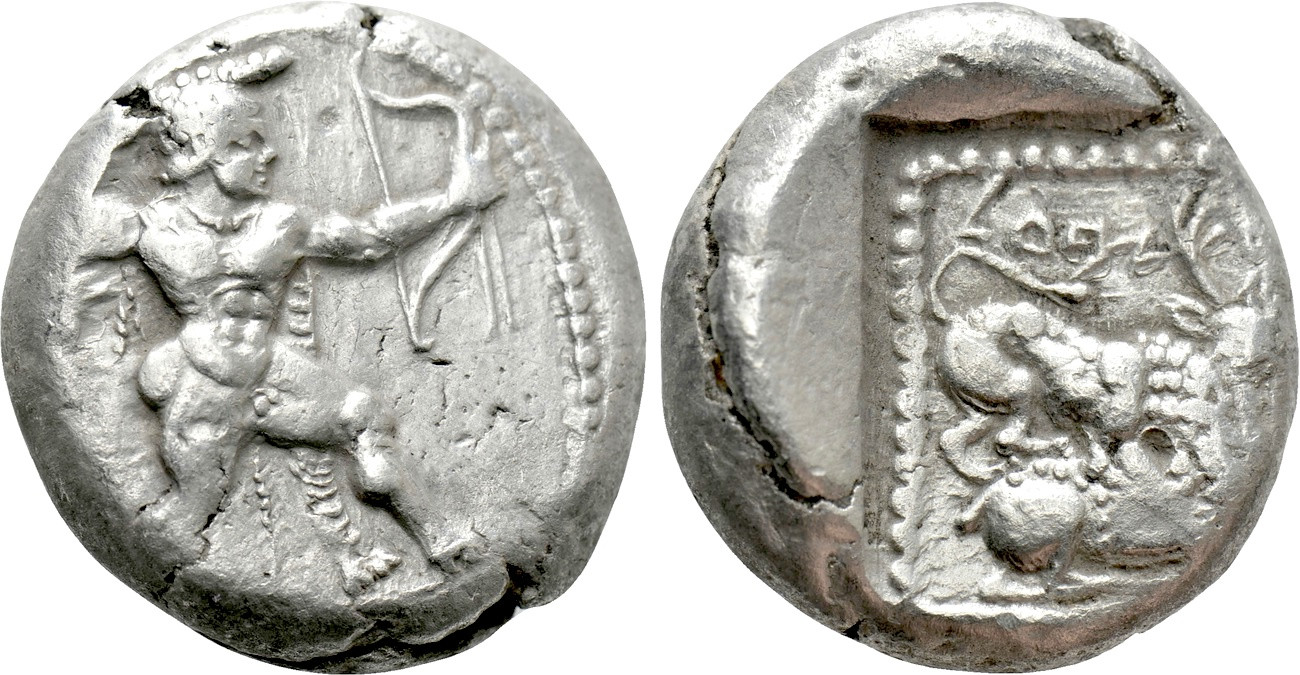2632 - Aspendus (double siglos hoplite/triskeles) over Citium (Heracles/lion and stag) (Roma Numismatics, EA 108, Apr. 2023, 446)
From SILVER
465 BCE - 430 BCE | ΕΣΤ
Location/history
| Sale(s)Sale(s) ᵖ: | Roma Numismatics, EA 108, 13 Apr. 2023, 446 | |
Overstriking coin
Description
| ObverseInscription or printing placed on the obverse.: | Warrior walking right, naked, wearing helmet, holding spear in right hand, shield attached on left arm. | ReverseInscription or printing placed on the reverse.: | ΕΣΤ Triskeles of human legs. All within incuse square. |
Mint and issuing power
| MintIdentifies the place of manufacture or issue of a numismatic object.: | Aspendus | Ancient regionAncient region. | Pamphylia | Modern countryModern country: Turkey | AuthorityIdentifies the issuing power. The authority can be "pretended" when the name or the portrait of X is on the coin but he/she was not the issuing power. It can also be "uncertain" when there is no mention of X on the coin but he/she was the issuing power according to the historical sources: | Persian Empire |
Chronology
| FromIdentifies the initial date in a range assigned in a numismatic context. 465 BCE toIdentifies the final date in a range assigned in a numismatic context.. 430 BCE | Classical 480-323 BC |
Physical description
| MetalThe physical material (usually metal) from which an object is made.: Silver |
WeightWeight of the numismatic object (in grams). in grams: 10.7510.75 g <br />10,750 mg <br /> | DenominationTerm indicating the value of a numismatic object. Examples: tetradrachm, chalkous, denarius.: double siglos |
AxisDescribes the directional relationship between the obverse and reverse of a numismatic object.: 1111 mm <br />1.1 cm <br /> |
| DiameterDescribes diameter of an object (in mm).: 2323 mm <br />2.3 cm <br /> | StandardStandard.: Persian | ||
References
| Coin referenceReference of the Coin: | Coin series referenceReference to coin series study: | Babelon 1901-19321Babelon 1901-1932, Tome 1, Part 2, p. 526-530, n° 855-867, SNG Copenhagen Lycia-Pamphylia2SNG Copenhagen Lycia-Pamphylia, n° 153-179, SNG von Aulock Pamphylien3SNG von Aulock Pamphylien, n° 4477-81, SNG France 34SNG France 3, n° 1-11 | |
| Coin series web referenceCoin series web references: | |||
Overstruck type
Description
| ObverseInscription or printing placed on the obverse.: | Herakles in fighting stance right, holding club and bow, with lion skin draped from neck | ReverseInscription or printing placed on the reverse.: | Lion attacking stag right, all within pelleted square border within incuse square |
Mint and issuing power
| MintIdentifies the place of manufacture or issue of a numismatic object. ᵖ: | Citium | Ancient regionAncient region. ᵖ | Cyprus | Modern countryModern country: Greece | AuthorityIdentifies the authority in whose name (explicitly or implicitly) a numismatic object was issued. ᵖ: | Azbaal of Citium (Phoenician king of Citium and Idalium, 5th c BC) |
Chronology
| FromIdentifies the initial date in a range assigned in a numismatic context. 449 BCE toIdentifies the final date in a range assigned in a numismatic context.. 425 BCE | Classical 480-323 BC |
Physical description
| DenominationTerm indicating the value of a numismatic object. Examples: tetradrachm, chalkous, denarius. ᵖ: | stater |
References
| Coin type referenceReference to coin series study ᵖ: | |||
| Coin series web reference overstruckCoin series web references overstruck: | |||
Additional data
| Frequency of overstrikesFrequency of overstrikes: | frequent | Level of confidenceLevel of confidence of the identification: | strong |
| RemarksRemarks: | "overstruck on an uncertain type, the pelleted square border of which can be seen clearly in front of the hoplite on the obv." (nb: and the tail of the lion) | ||
References
- ^ Babelon, Ernest (1901-1932), Traité des monnaies grecques et romaines, Paris, E. Leroux
- ^ Breitenstein, Niels (1955), Sylloge Nummorum Graecorum: Royal Collections of coins and medals. Danish National Museum, 31, Lycia-Pamphylia.
- ^ Sylloge Nummorum Graecorum. Sammlung v. Aulock. Pamphylien. 11 Heft (n° 4477-4893), Berlin, 1965.
- ^ Levante, Edoardo [with the collaboration of Peter Weiss] (2001), Sylloge nummorum graecorum. France. 3, Département des monnaies, médailles et antiques : Pamphylie, Pisidie, Lyaconie, Galatie, Paris-Zürich, Bibliothèque nationale de France-Numismatica Ars Classica, XXXIV + 293 p. and 146 pl.

